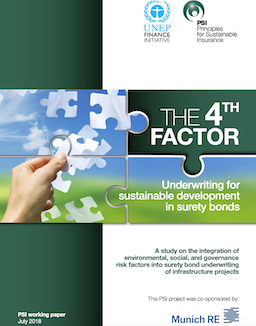
The 4th Factor: underwriting for sustainable development in surety bonds
A study on the integration of environmental, social, and governance risk factors into surety bond underwriting of infrastructure projects.
This PSI project was co-sponsored by Munich Re
Download the report here.
About this report
This report presents the findings of a study on the integration of environmental, social and governance (ESG) risk factors into surety bond underwriting of infrastructure projects. The study is based on a global survey and consultation on current underwriting practices of insurance and reinsurance companies.
Sponsored by Munich Re and the International Finance Corporation of the World Bank Group, the study was carried out by UN Environment’s Principles for Sustainable Insurance Initiative (PSI) through an alliance of insurers, reinsurers and academics.
The aim of this report is to contribute to the development of global guidance on the integration of ESG risks into insurance underwriting across lines of business and industry sectors, including surety bonds and infrastructure projects.
The project
Infrastructure developments such as ports, bridges, hydroelectric plants, grids, pipelines, and tunnels entail substantial completion and performance risks. Since infrastructure projects are exposed to these risks, engineering, procurement, and construction (EPC) contractors are often required to provide completion guarantees. Such guarantees can take the form of surety bonds, a specialised line of business in the insurance industry.
A surety bond is defined as a three-party agreement that legally binds together a principal (contractor) who needs the bond, an obligee (project owner) who requires the bond, and an obligor (the surety, usually an insurance company) that sells the bond. The bond guarantees the principal will act in accordance with certain laws. If the principal fails to perform in this manner, the bond will cover resulting damages or losses.2
A surety bond is an efficient tool to select contractors and to increase the likelihood of project completion in the event of default (Al-Sobiei, Arditi, & Polat, 2005; Awad & Fayek, 2012).
They are cost-effective and do not rely on the limited lending capacity of commercial banks.
In the insurance industry, underwriting is the process of evaluating, defining and pricing risks. Surety bond underwriting typically involves the assessment of the three C’s: capital (financial strength), capacity (ability to perform the contract), and character (integrity, reliability and commitment to meet obligations). However, current practices in surety bond underwriting vary across companies and markets.
In this context, a global survey and consultation was carried out with the guiding principle that the integration of environmental, social and governance (ESG) risk factors into the surety bond underwriting process could benefit all stakeholders involved in construction projects, and contribute to economic, social and environmental sustainability—in other words, sustainable development.
Key findings
- ESG risk factors influence surety bond underwriting decisions
- ESG risks represent a “fourth C” in surety bond underwriting
- Surety bond underwriters want and need guidelines to better integrate ESG risks into the underwriting process
- Surety bond underwriting guidelines are currently more developed on social and governance risk factors than environmental risk factors. Building capacity on integrated ESG risk management is necessary
Acknowledgements
This PSI project was a collaborative effort involving UN Environment, Munich Re, the International Finance Corporation of the World Bank Group, Allianz, Generali, IAG, the International Credit Insurance & Surety Association (ICISA), the Panamerican Surety Association (PASA), the UTS Business School at the University of Technology Sydney, the Fox School of Business at Temple University, and West Chester University of Pennsylvania.


